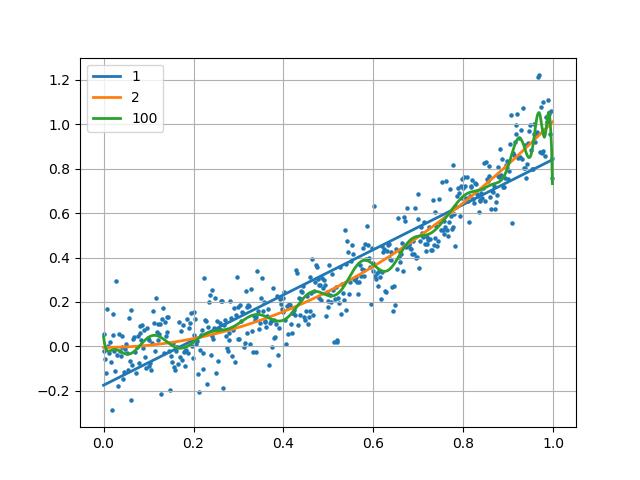机器学习中的预测问题通常分为2类:回归与分类
Posted 何爱平
tags:
篇首语:本文由小常识网(cha138.com)小编为大家整理,主要介绍了机器学习中的预测问题通常分为2类:回归与分类相关的知识,希望对你有一定的参考价值。
回归就是预测数值,而分类是给数据打上标签归类。
本例中使用一个2次函数加上随机的扰动来生成500个点,然后尝试用1、2、100次方的多项式对该数据进行拟合。
拟合的目的是使得根据训练数据能够拟合出一个多项式函数,这个函数能够很好的拟合现有数据,并且能对未知的数据进行预测。
import matplotlib.pyplot as plt
import numpy as np
import scipy as sp
from scipy.stats import norm
from sklearn.pipeline import Pipeline
from sklearn.linear_model import LinearRegression
from sklearn.preprocessing import PolynomialFeatures
from sklearn import linear_model
\'\'\' 数据生成 \'\'\'
x = np.arange(0, 1, 0.002)
y = norm.rvs(0, size=500, scale=0.1)
y = y + x**2
\'\'\' 均方误差根 \'\'\'
def rmse(y_test, y):
return sp.sqrt(sp.mean((y_test - y) ** 2))
\'\'\' 与均值相比的优秀程度,介于[0~1]。0表示不如均值。1表示完美预测.这个版本的实现是参考scikit-learn官网文档 \'\'\'
def R2(y_test, y_true):
return 1 - ((y_test - y_true)**2).sum() / ((y_true - y_true.mean())**2).sum()
\'\'\' 这是Conway&White《机器学习使用案例解析》里的版本 \'\'\'
def R22(y_test, y_true):
y_mean = np.array(y_true)
y_mean[:] = y_mean.mean()
return 1 - rmse(y_test, y_true) / rmse(y_mean, y_true)
plt.scatter(x, y, s=5)
degree = [1,2,100]
y_test = []
y_test = np.array(y_test)
for d in degree:
clf = Pipeline([(\'poly\', PolynomialFeatures(degree=d)),(\'linear\', LinearRegression(fit_intercept=False))])
clf.fit(x[:, np.newaxis], y)
y_test = clf.predict(x[:, np.newaxis])
print(clf.named_steps[\'linear\'].coef_)
print(\'rmse=%.2f, R2=%.2f, R22=%.2f, clf.score=%.2f\'%
(rmse(y_test, y),R2(y_test, y), R22(y_test, y),
clf.score(x[:, np.newaxis], y)))
plt.plot(x, y_test, linewidth=2)
plt.grid()
plt.legend([\'1\',\'2\',\'100\'], loc=\'upper left\')
plt.show()

原文出处:https://blog.csdn.net/lsldd/article/details/41251583(转载)
以上是关于机器学习中的预测问题通常分为2类:回归与分类的主要内容,如果未能解决你的问题,请参考以下文章